Covid, how infections and hospitalizations decline. Gimbe Report

Facts, numbers, comparisons, scenarios and advice. What emerges from the monitoring of the Gimbe Foundation on the progress of the pandemic and the vaccination campaign
From 2 to 8 February, the new cases of Covid-19 in Italy see, for the second consecutive week, a sharp decline, recording a -27.9%.
They were, in fact, 649,345 compared to the 900,027 of the previous week.
A decrease due, "in part to the lower circulation of the virus, documented by the reduction in the positive rate of the swabs, and in part to the reduction in swabs" which, between antigenic and molecular, fell by 15.5% in the same period of time .
This is revealed by the new monitoring of the Gimbe Foundation, from which comes the warning: "the data legitimize cautious optimism, not risky moves".
“The data legitimizes a cautious optimism aimed at the gradual easing of the measures. However, with the expiry of the state of emergency approaching – the extension of which is no longer justifiable in Parliament – terms that have nothing to do with the current situation are insinuating themselves into the scientific and political debate: from the endemic circulation of the virus even to the 'imminent end of the pandemic – Distortions of reality that are very dangerous because excess of optimism and disinformation, if on the one hand they do not help to counter the vaccination hesitation, on the other hand they risk legitimizing risky and risky decisions, such as the forfeiture of the obligation to mask in closed environments ".
85.4% of the population has received at least one dose of the vaccine and 82% have completed the vaccination course, but 7.1 million people have not yet received even one dose. The coverage rate of third doses is, on the other hand, 83.5% but with clear regional differences: it ranges from 77.5% in Sicily to 89% in Valle D'Aosta. This was revealed by the new independent monitoring of the Gimbe Foundation, updated on 9 February at 6 am.
The slow decline in the weight of the Covid-19 pandemic on hospitals continues. In the week 2-8 February there was a 7.7% reduction in hospitalizations with symptoms, which were 18,337 compared to 19,873 the previous week. Similarly, there is also an 11.2% reduction in ICU admissions, which were 1,376 compared to 1,549. While there are no signs of decreasing deaths, which were 2,587 (+ 0.2%), of which 251 referred to previous periods.
In the week 2-8 February, with the exception of Calabria, Sardinia and Sicily (which are affected by the recalculations of the last week), in all the Regions there is a percentage reduction in new cases, ranging from -9.4% in Basilicata to -50.4% of the Aosta Valley. But there are still 70 Provinces with an incidence exceeding 1,000 cases per 100,000 inhabitants, distributed in all Regions with the exception of Molise and Valle d'Aosta.
There is also a further decline in new vaccinated against Covid-19: they were 186,744 compared to 278,940 in the previous week, equal to -33.1%. In particular, in the 5-11 age group there were 77,985, with a clear decrease of -35.2% compared to the previous week. Despite the vaccination obligation and the reinforced green pass obligation in the workplace, among the over 50s the number of new vaccinated people on a weekly basis still drops, reaching 47,951, equal to -41.6% compared to the previous week.
+++
HERE IS THE FULL REPORT OF THE GIMBE FOUNDATION:
The independent monitoring of the Gimbe Foundation detects in the week 2-8 February 2022, compared to the previous one, a reduction in new cases (649.345 vs 900.027) (figure 1) compared to a number of deaths that shows no sign of decreasing (2.587 vs 2.581) (figure 2). Currently positive cases are also decreasing (1,927,800 vs 2,476,514), people in home isolation (1,908,087 vs 2,455,092), hospitalizations with symptoms (18,337 vs 19,873) and intensive care (1,376 vs 1,549) (figure 3). In detail, compared to the previous week, the following changes were recorded:
- Deaths: 2,587 (+ 0.2%), of which 251 referred to previous periods
- Intensive care: -173 (-11.2%)
- Hospitalized with symptoms: -1,536 (-7.7%)
- Home isolation: -547.005 (-22.3%)
- New cases: 649,345 (-27.9%)
- Currently positive cases: -548,714 (-22.2%)
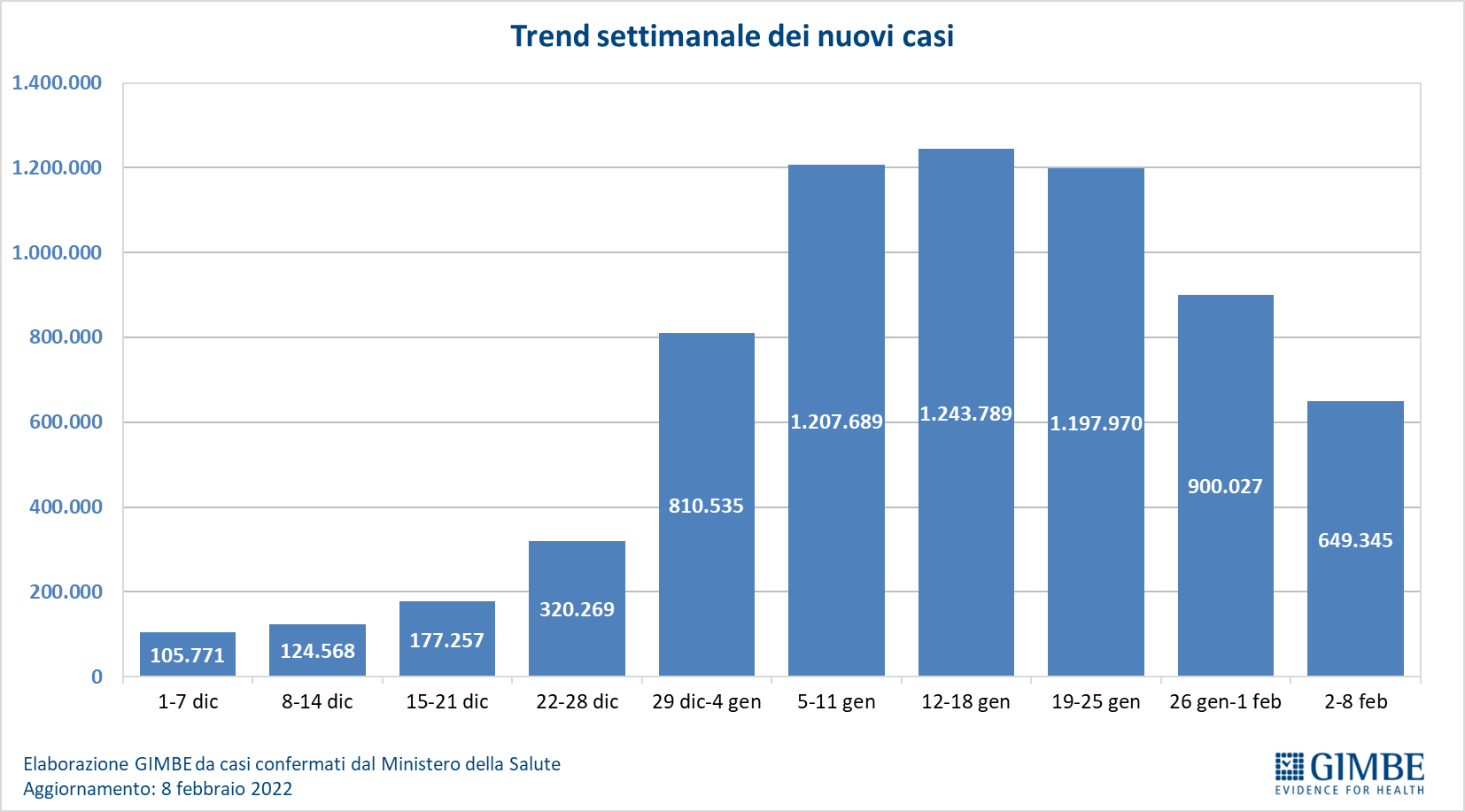
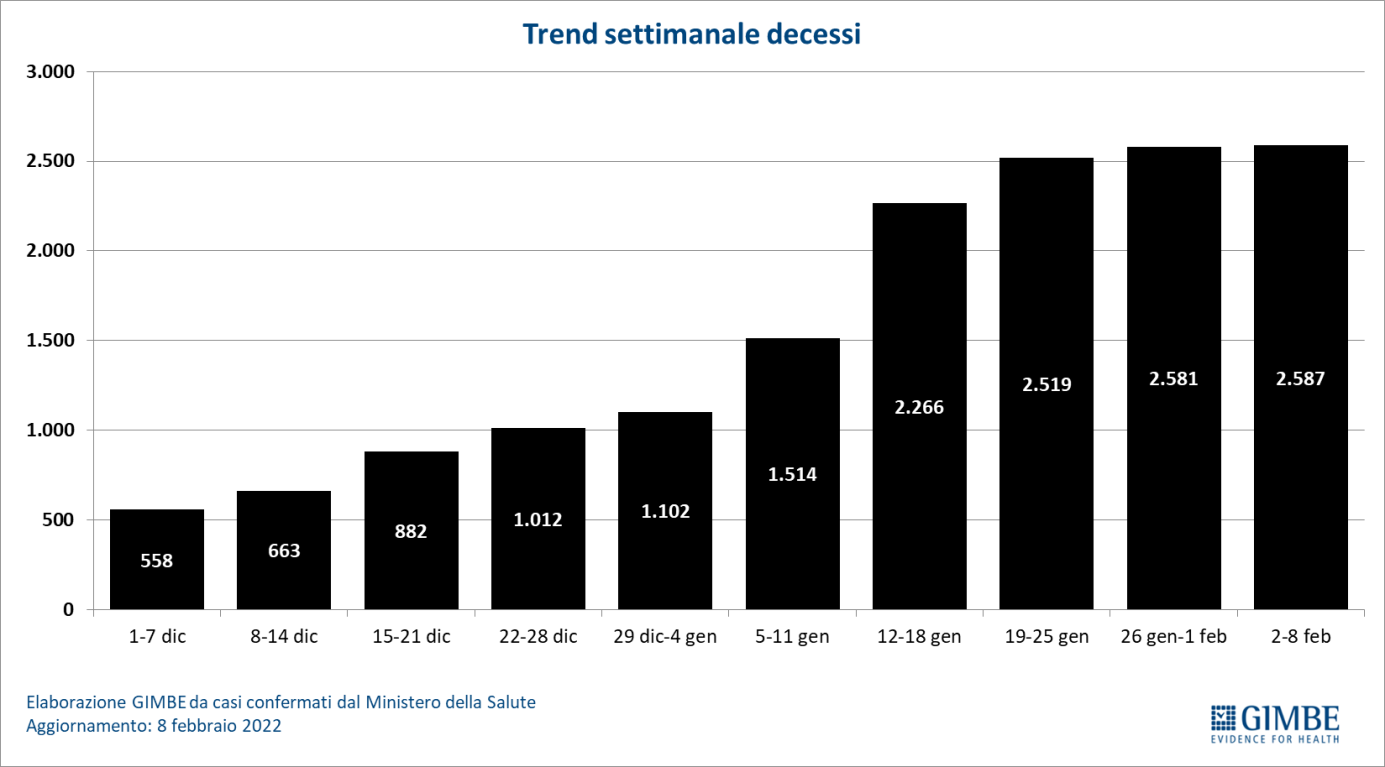
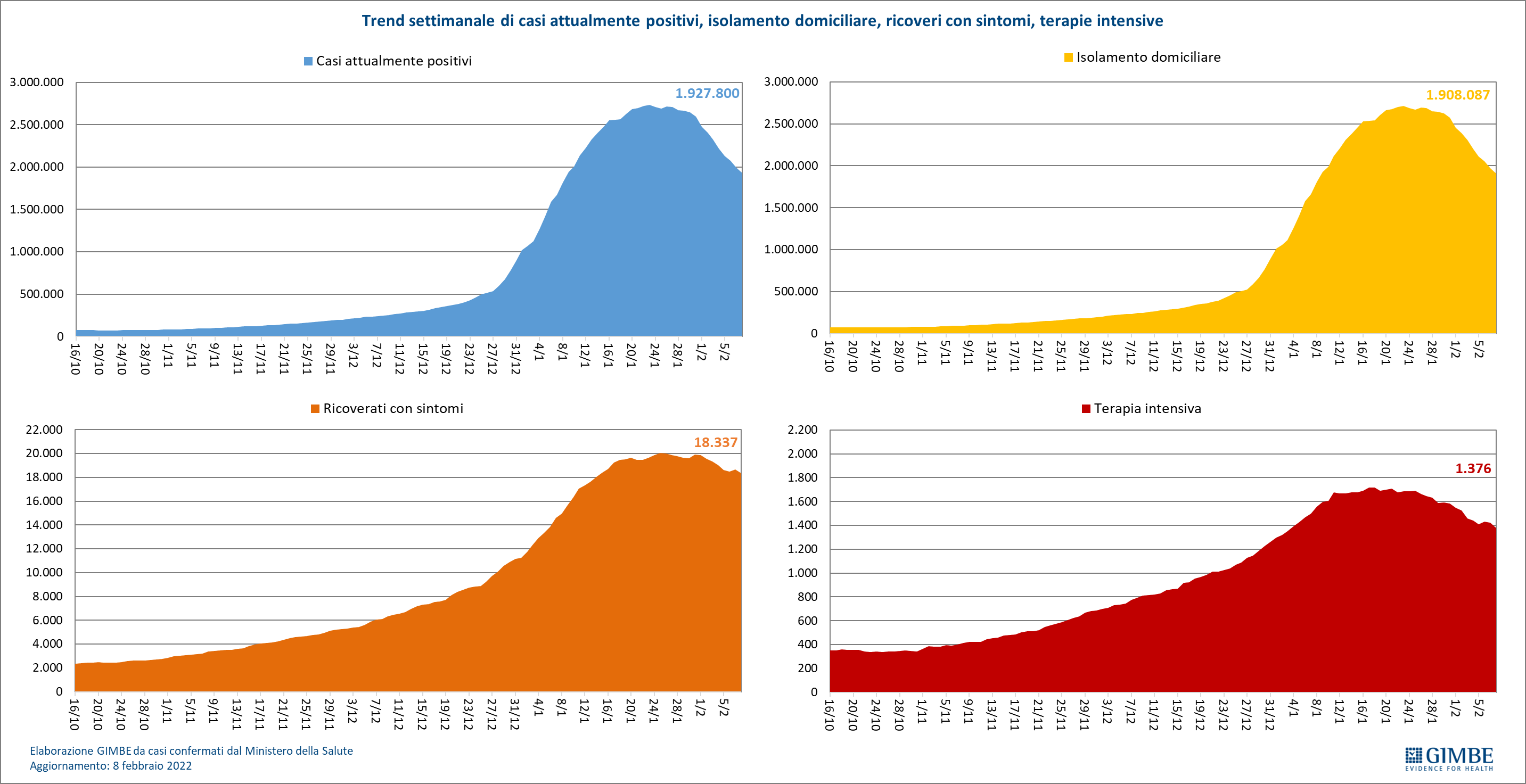
New cases. "The new weekly cases – declares Nino Cartabellotta, President of the Gimbe Foundation – show a sharp decline for the second consecutive week: about 650 thousand with a reduction of 27.9% compared to the previous week and a 7-day moving average that falls from 121,741 cases on February 2 to 92,764 on February 8 (-23.8%). This figure is partly due to the lower circulation of the virus, documented by the reduction in the positive rate of the swabs, in part by the decrease in the swabs "(figure 4).
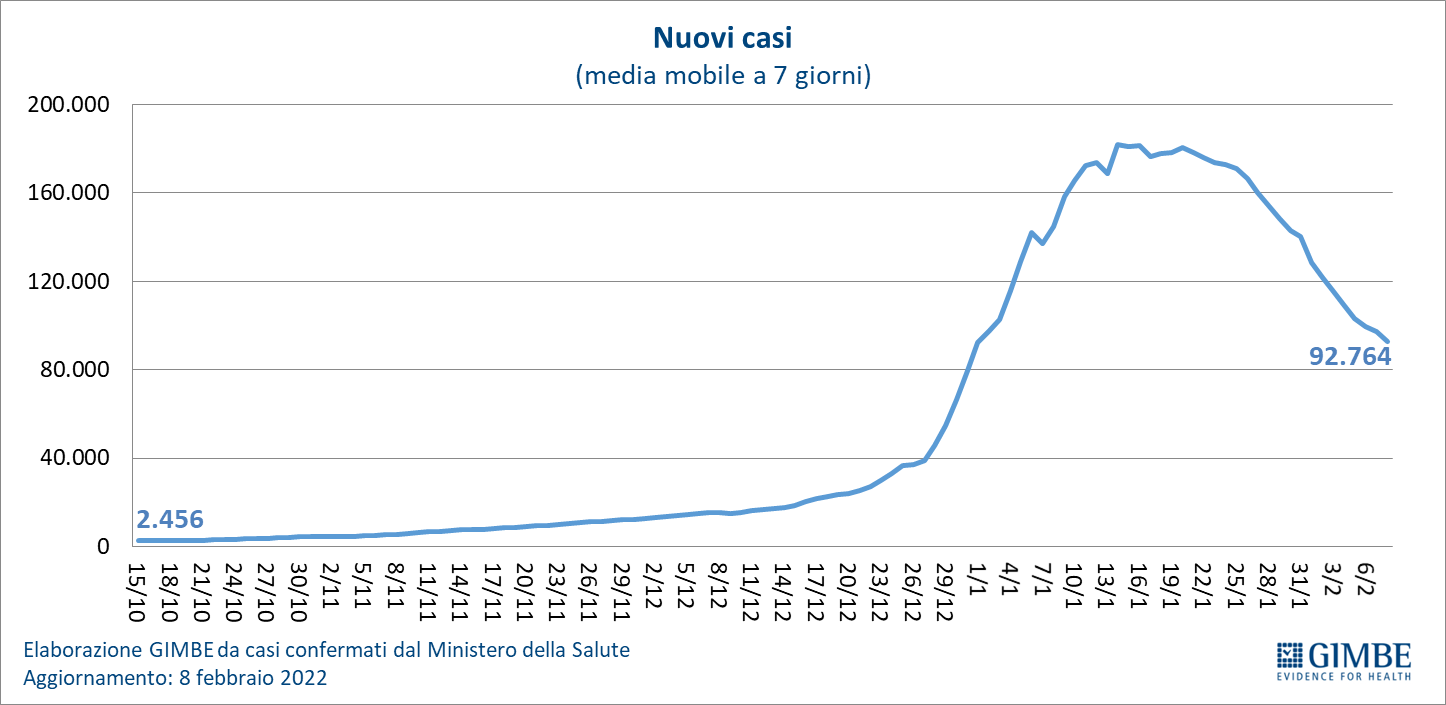
In the week 2-8 February, with the exception of Calabria, Sardinia and Sicily (which are affected by the recalculations of the last week), in all the Regions there is a percentage reduction in new cases: from -9.4% in Basilicata to – 50.4% of the Aosta Valley (table 1). There are 70 Provinces with an incidence greater than 1,000 cases per 100,000 inhabitants, distributed in all Regions except Molise and Valle d'Aosta (table 2).
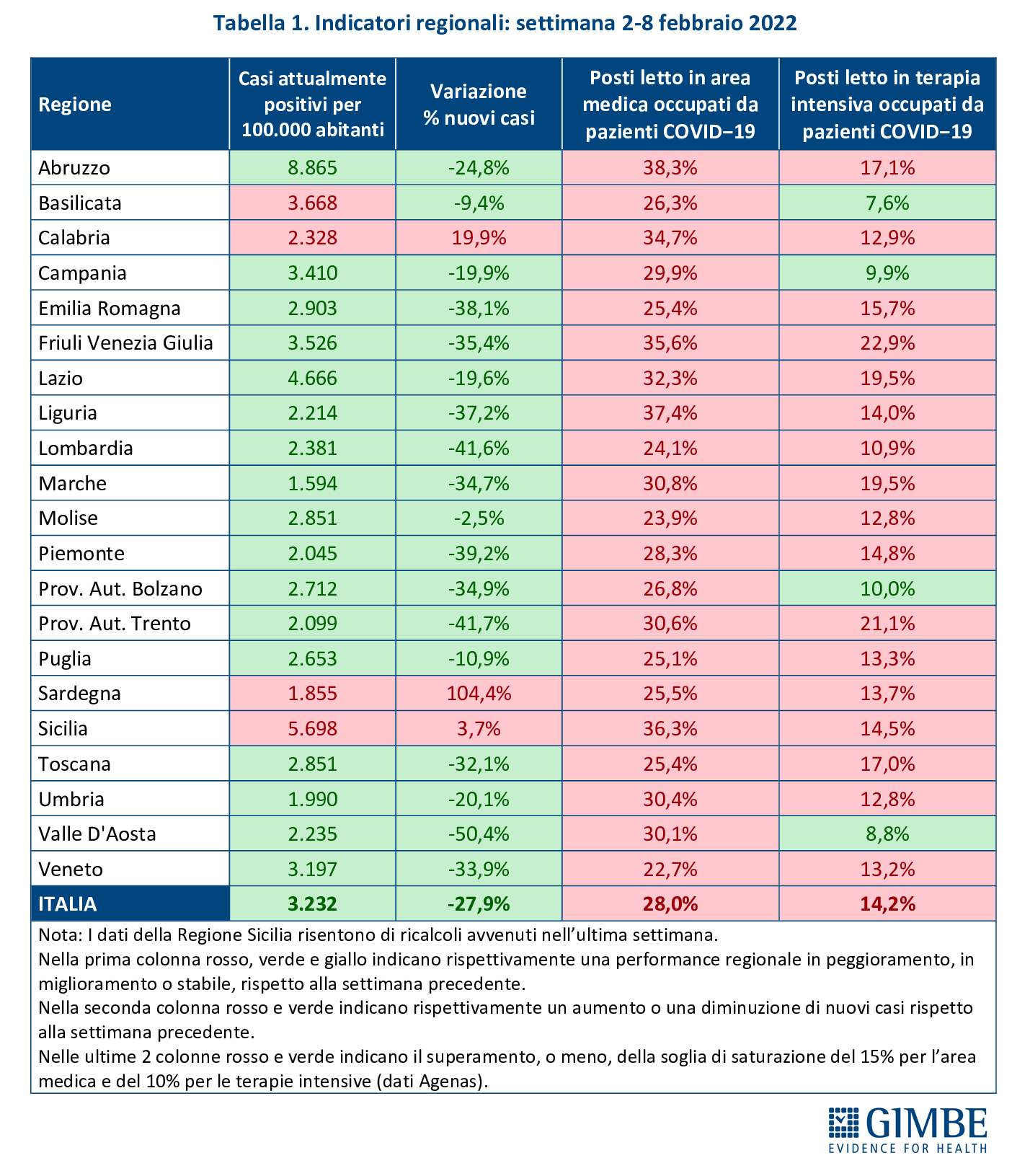

Testing.
There was a decrease in the number of total tampons (-15.5%), which went from 6,731,291 in the week of January 26-February 1 to 5,690,533 in the week of February 2-8. In detail, rapid buffers were reduced by 16% (-848.590) and molecular buffers by 13.4% (-192.168) (figure 5). The 7-day moving average of the positivity rate of both molecular buffers (from 19.9% to 16.5%) and rapid antigenic agents (from 11.6% to 9.9%) falls (Figure 6).
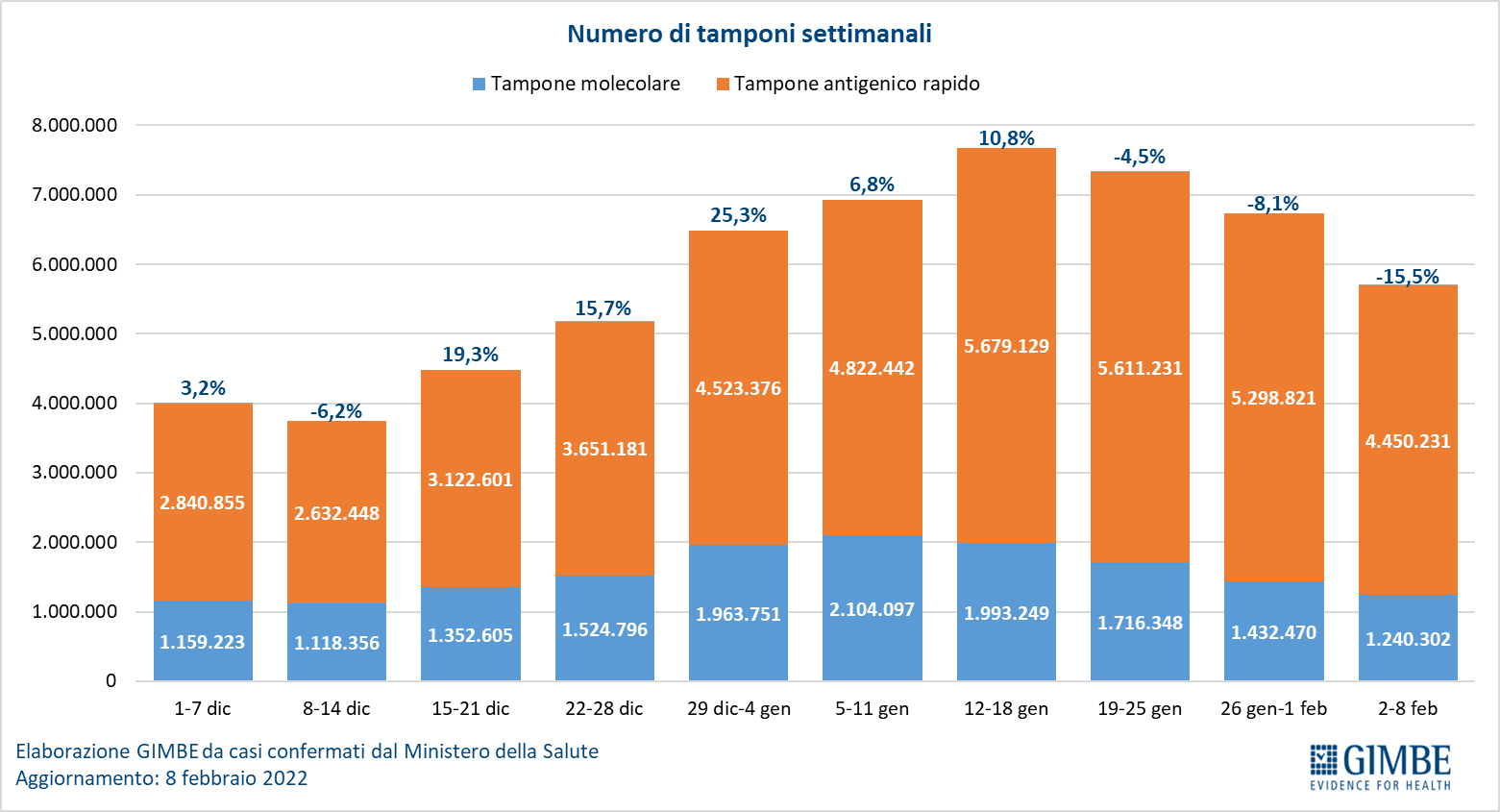
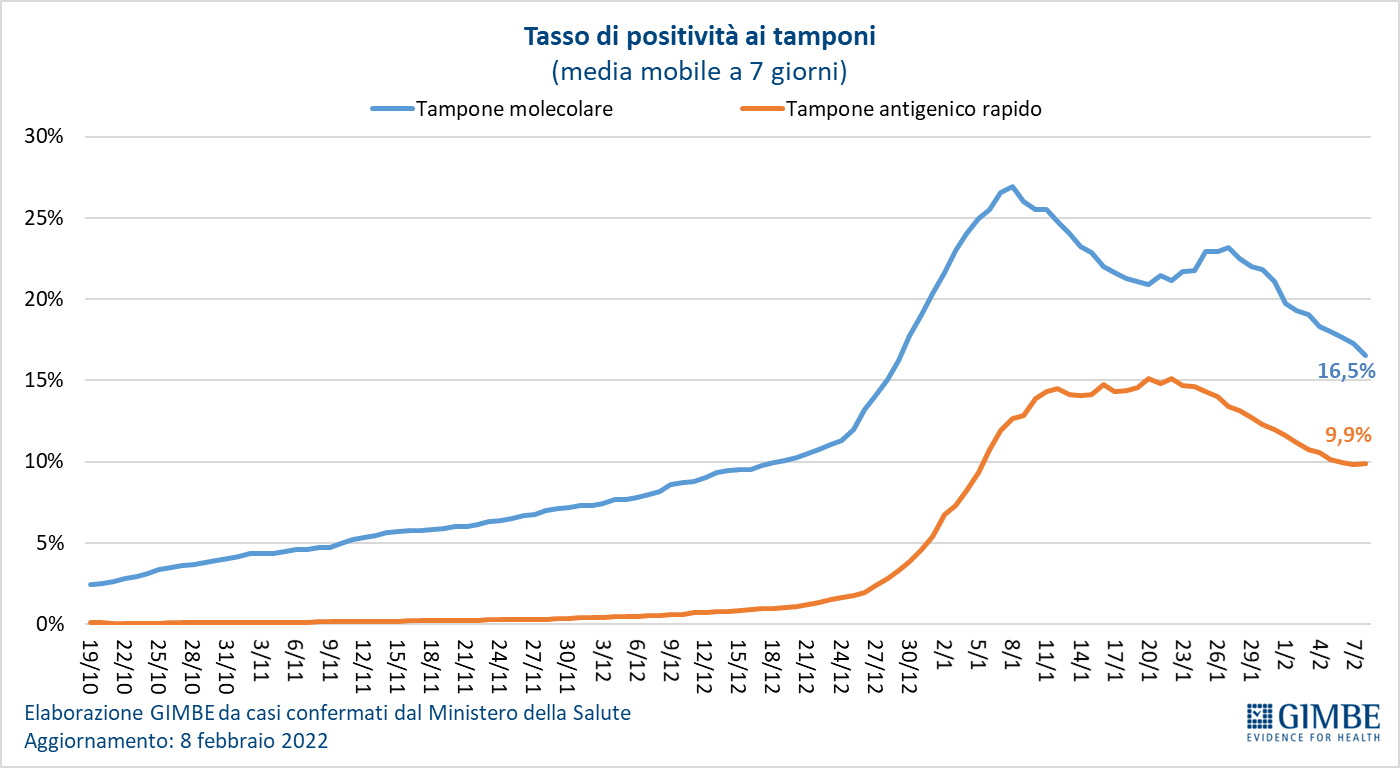
Hospitalizations.
"The pressure on hospitals is also reduced – says Renata Gili, Head of Research on Health Services of the Gimbe Foundation – even if more slowly than the new cases: compared to last week, the beds occupied by COVID patients decrease both in the medical area (-7 , 7%) and in intensive care (-11.2%) ". For intensive care, the decline that began in mid-January continues (from 1,717 on 17 January to 1,376 on 8 February) and the number of beds occupied in the medical area finally begins to decrease (from 19,913 on 31 January to 18,337 on February 8). February 8) (figure 7). As of February 8, the national employment rate for COVID patients was 28% in the medical area and 14.2% in the critical area. All Regions exceed the 15% threshold in the medical area; with the exception of Basilicata, Campania, the Autonomous Province of Bolzano and Valle d'Aosta, all go beyond the 10% threshold in the critical area (figure 8). "A further drop in daily admissions to intensive care is confirmed – points out Marco Mosti, Operations Director of the Gimbe Foundation – whose 7-day moving average drops to 99 admissions / day compared to 115 in the previous week" (figure 9).
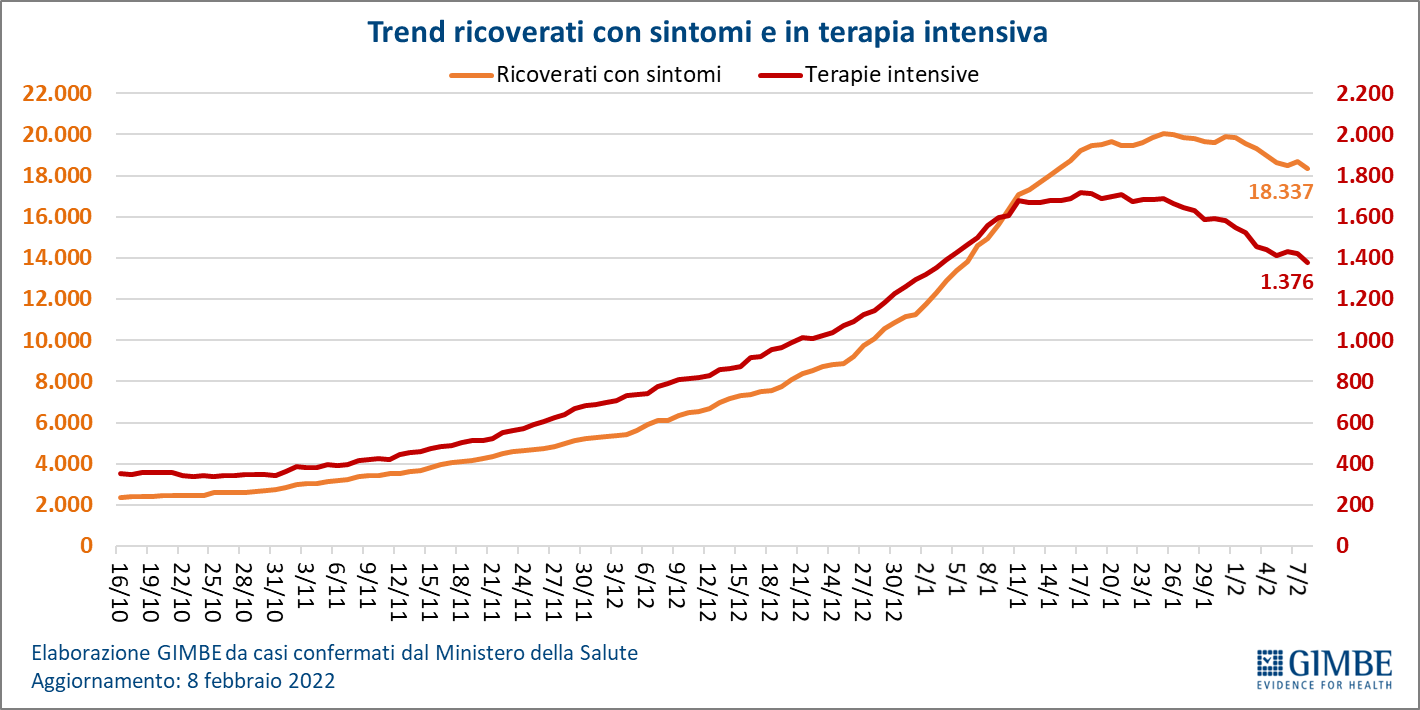
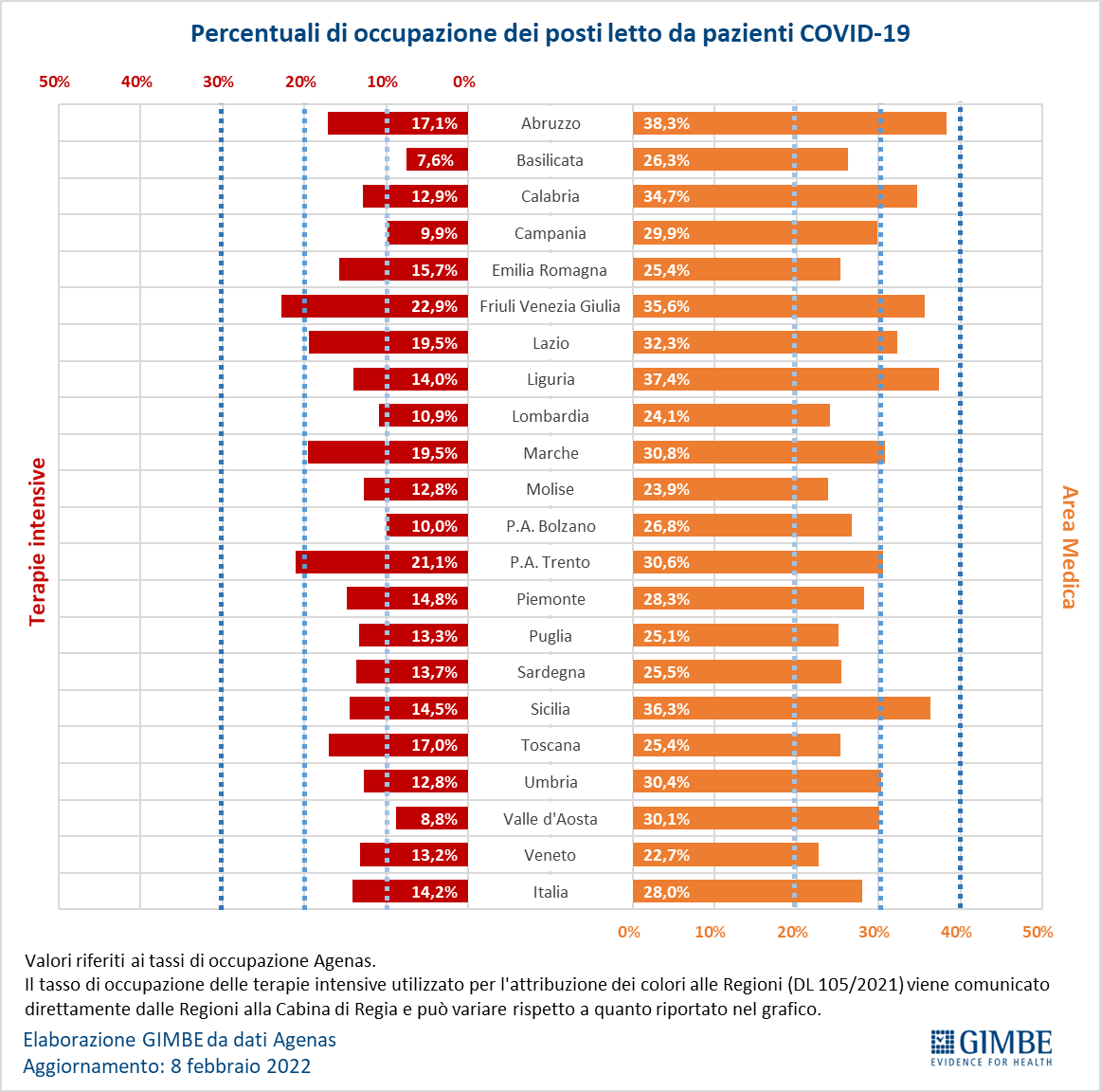
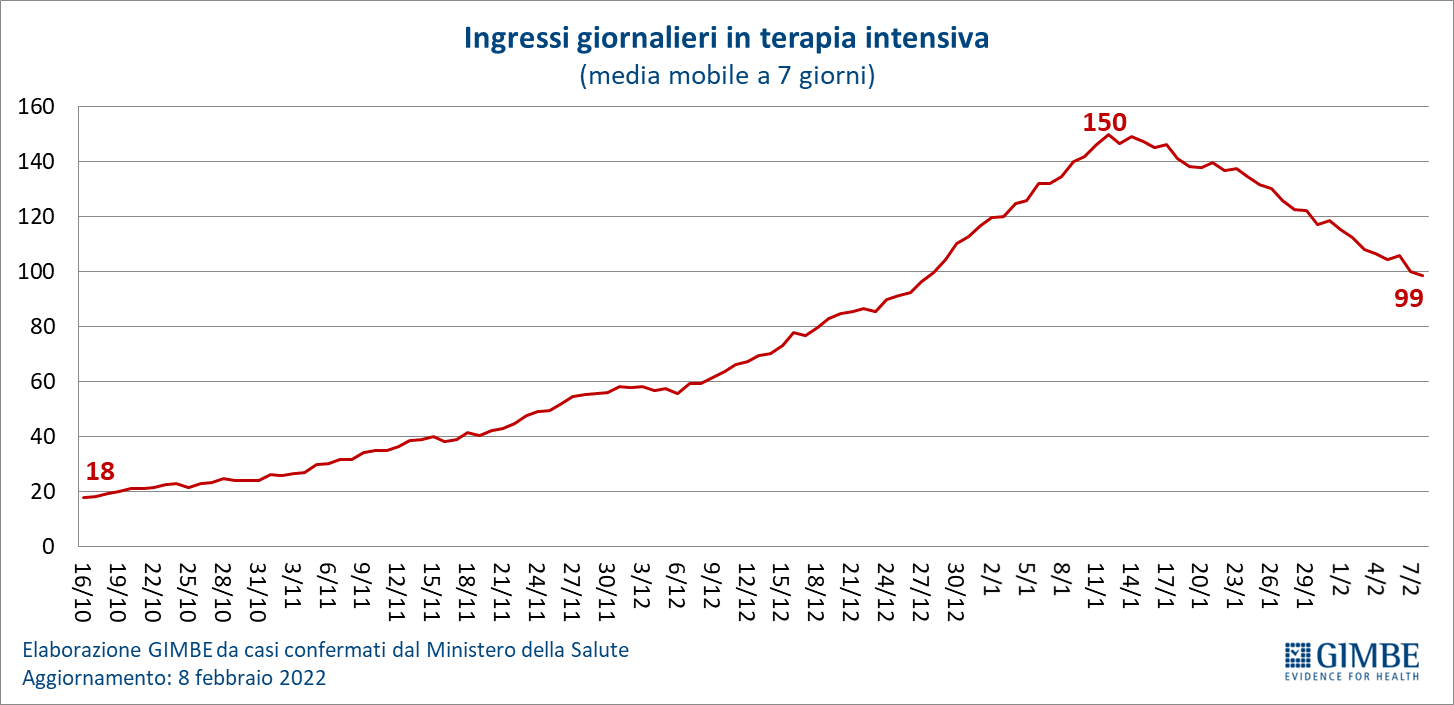
Deaths.
Deaths remained substantially stable: 2,587 in the last 7 days (of which 251 referred to previous periods), with an average of 370 per day compared to 369 in the previous week. These numbers, unfortunately still very high, in recent weeks have fueled distorted theories according to which many deaths of people positive to SARS-CoV-2 would have occurred anyway, regardless of the infection: theories disproved by the data on the excess mortality of the System of surveillance of daily mortality by the Ministry of Health , which are completely consistent with the official numbers of deaths. "The distinction between deaths" for "and deaths" with "COVID-19 – comments Cartabellotta – represents a useless exploitation of the data, because the real question to ask is: people affected by other diseases would still be alive if they had not been infected from SARS-CoV-2? The data confirm that for most of them the answer is yes. "
Vaccines: administrations.
As of February 9 (update 06.20) 85.4% of the population (n.50.578.779) received at least one dose of vaccine (+338.507 compared to the previous week) and 82% (n. 48.578.825) completed the vaccination cycle (+630.245 compared to the previous week) (figure 10). In the last week the number of administrations decreased (n. 2,217,463), with a 7-day moving average of 316,780 administrations / day: the third doses decreased by 40.1% (n. 1,580,389) and by 33, 1% newly vaccinated (186,744) (figure 11).
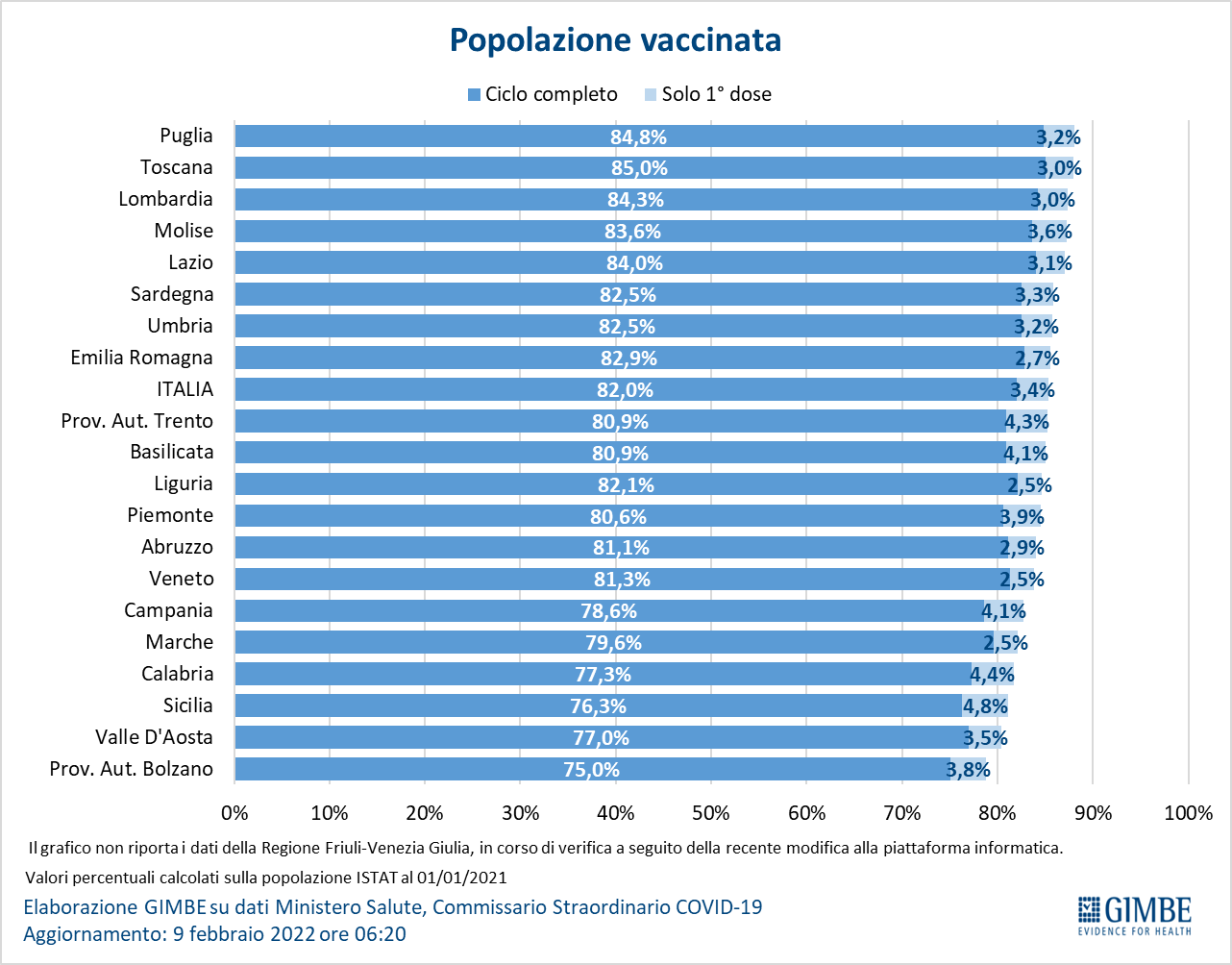
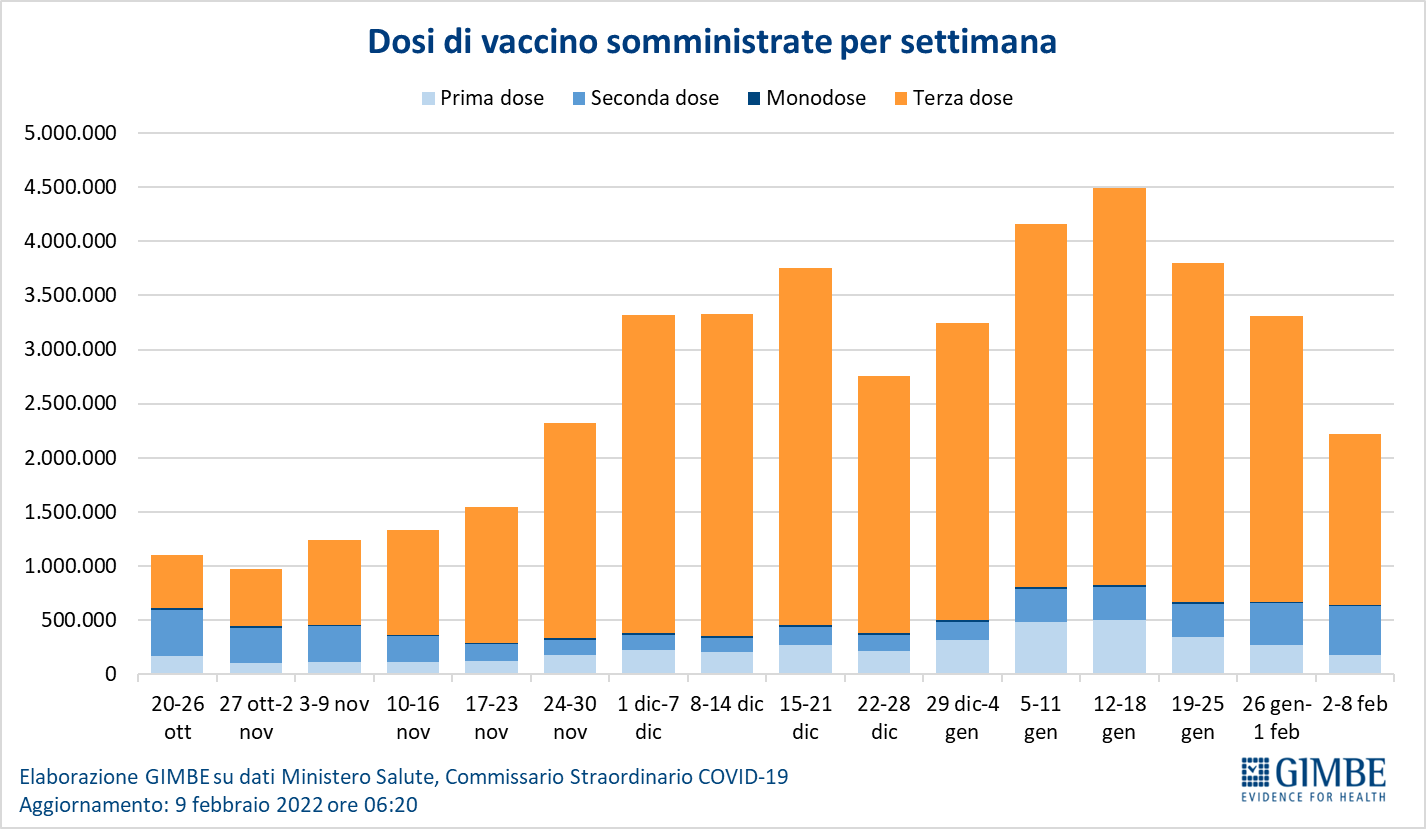
Vaccines: covers. Coverage with at least one dose of vaccine is highly variable in the different age groups (from 99.4% of the over 80s to 34.9% of the 5-11 range), as well as in terms of recalls, which in the over 80s have reached 86.7%, 85.1% in the 70-79 age group and 81% in the 60-69 age group (figure 12).
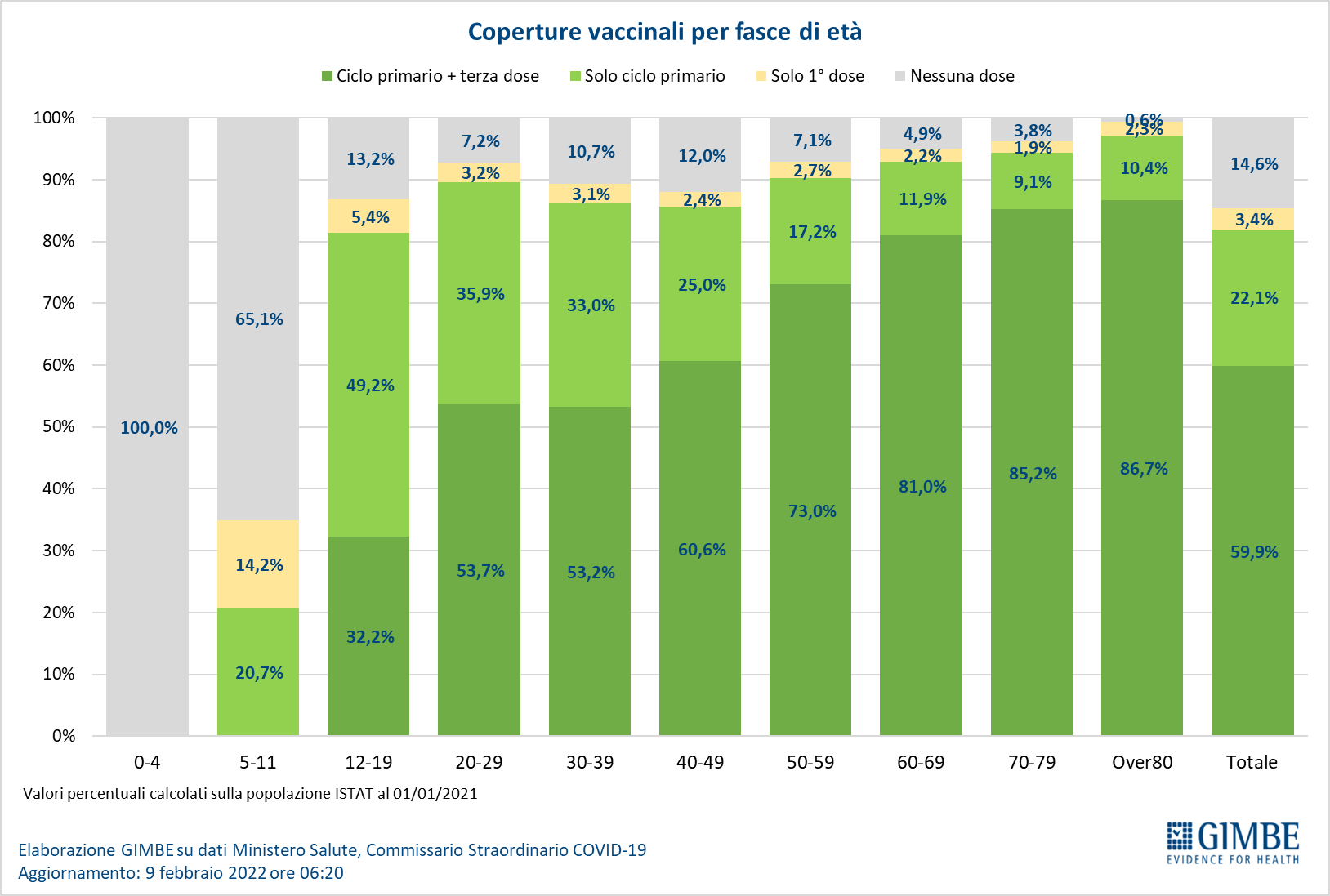
Vaccines: new vaccinated.
In the week 2-8 February there was a further decline in the number of new vaccinated: 186,744 compared to the 278,940 of the previous week (-33.1%) (figure 13). Of these, 41.8% is represented by the 5-11 bracket: 77,985, a sharp decline compared to the previous week (-35.2%). Despite the entry into force of the vaccination obligation and the imminent introduction of the reinforced green pass obligation in the workplace, among the over 50s the number of new vaccinated persons drops further, reaching 47,951 (-41.6% compared to the previous week) (figure 14). The bands 12-19 and 20-49 are also constantly decreasing (figure 15).
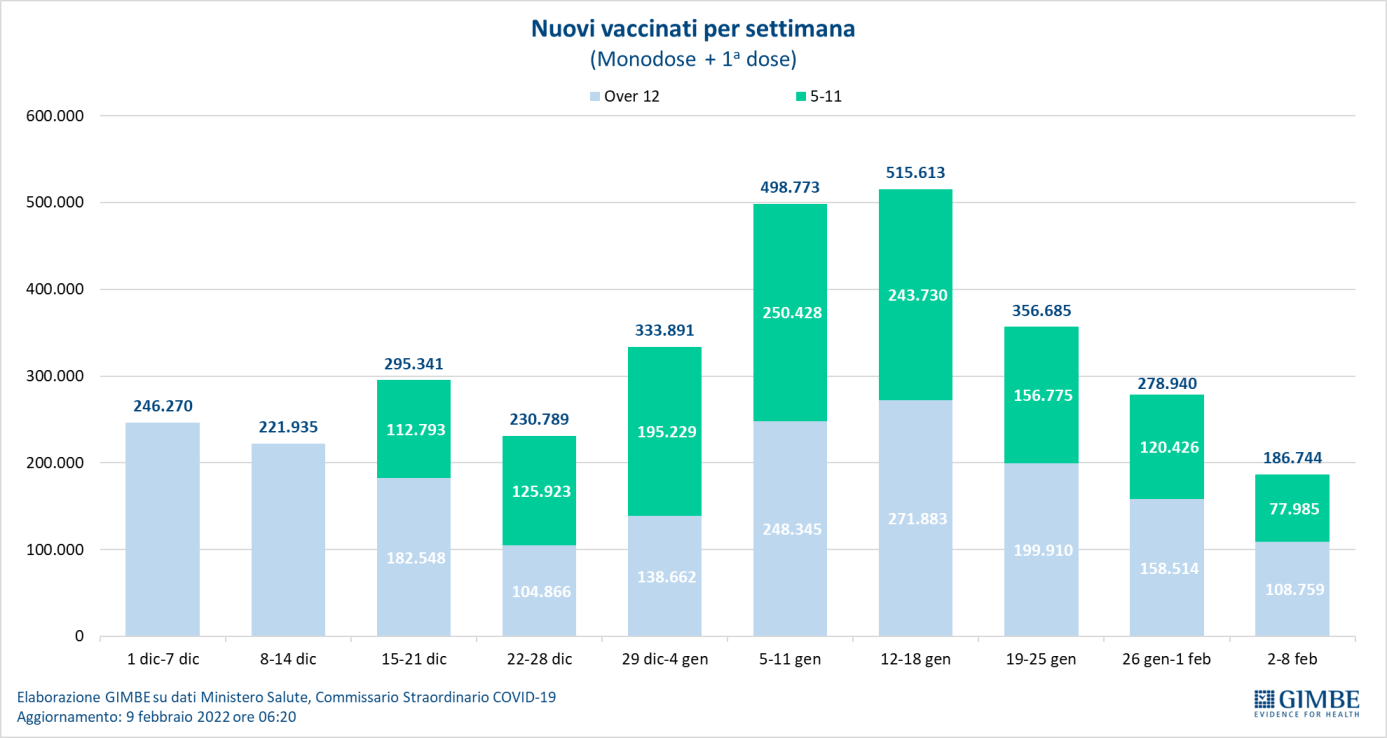
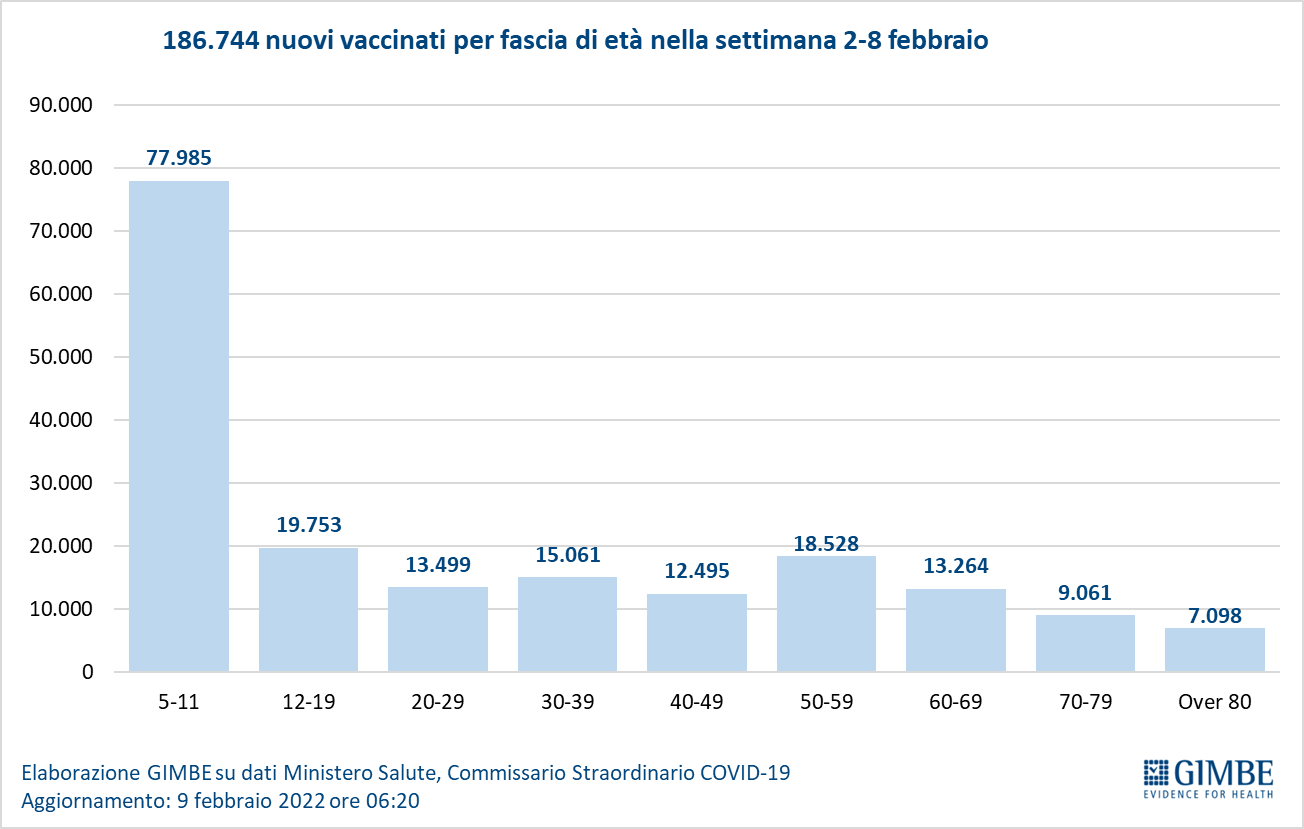
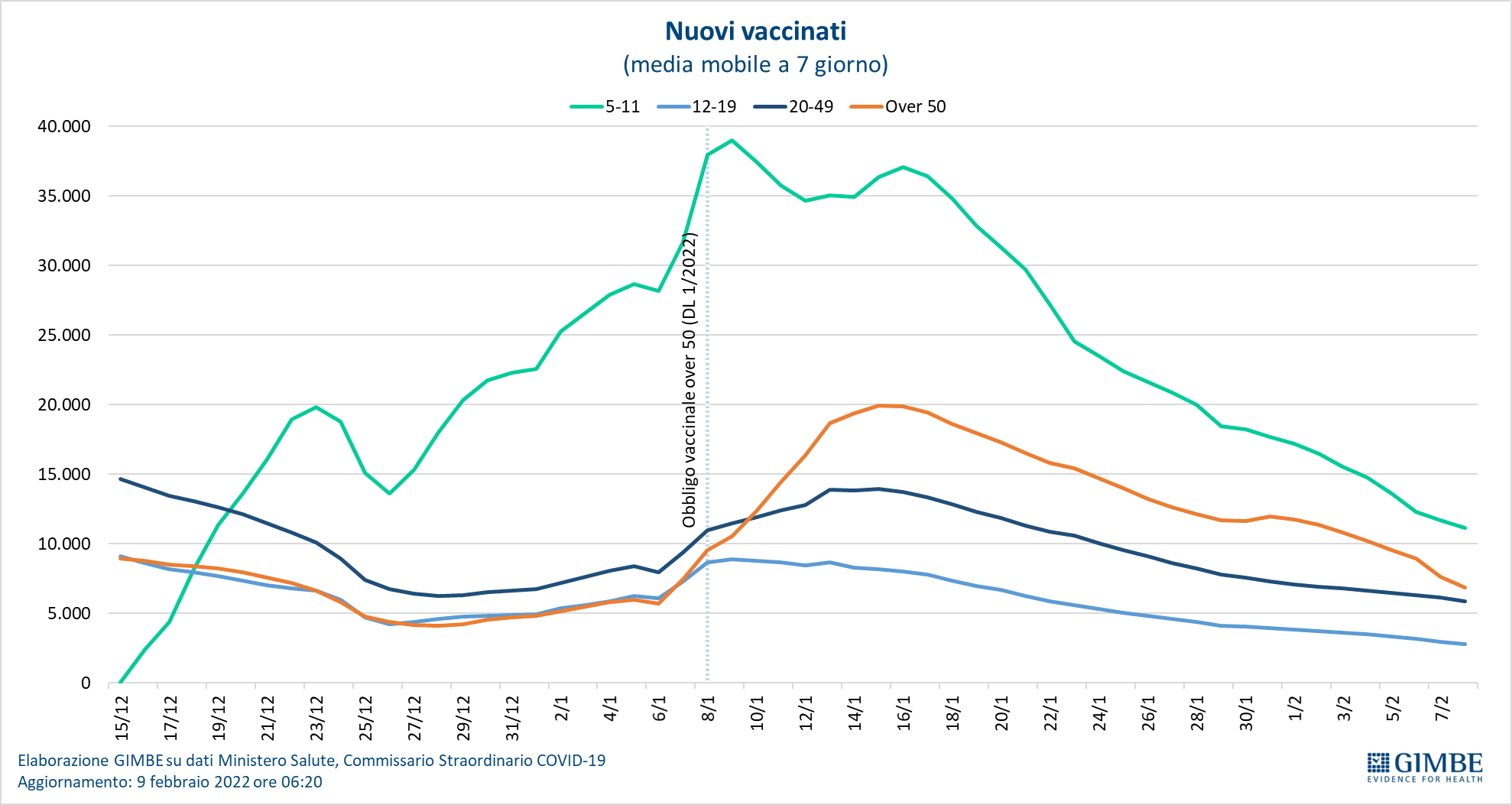
As of February 8, 7.1 million people are still without even a dose of vaccine, of which 1.8 million recovered less than 180 days and 5.3 million vaccinated (Figure 16). These data lead to two considerations: if on the one hand the fact that over 1.7 million people have come into contact with the virus raises the level of immunity of the population, on the other hand the number of people not protected by COVID-19 is still very high and, above all, the immunity deriving from the infection gradually decreases over time, confirming the need to be vaccinated within 6 months of the infection.
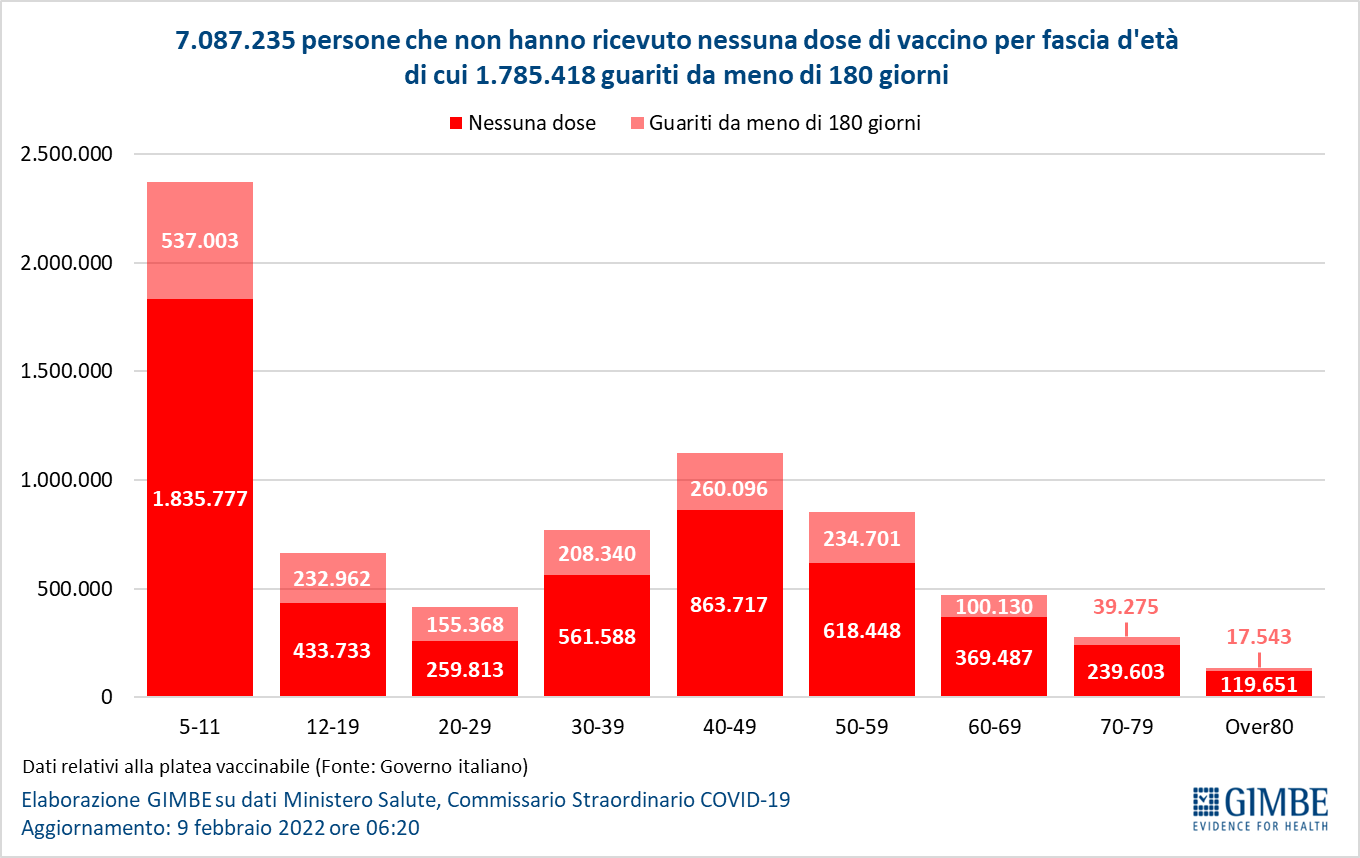
Vaccines: age range 5-11.
As of February 9 (update 06.20), 1,903,023 doses have been administered in the 5-11 year range (figure 17): 1,283,289 have received at least 1 dose of vaccine (of which 761,023 have completed the vaccination cycle), with an national coverage which stands at 34.9% with clear regional differences (from 18.9% in the Autonomous Province of Bolzano to 51.5% in Puglia) (figure 18).
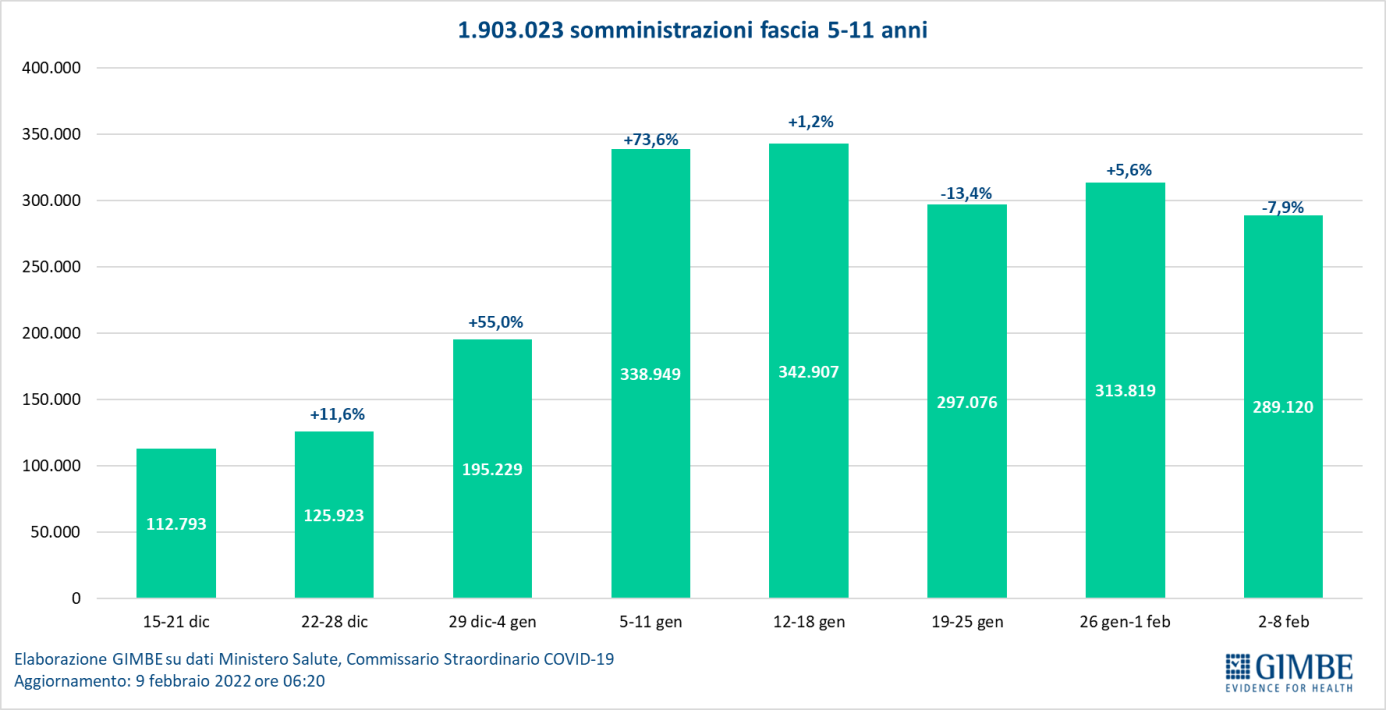
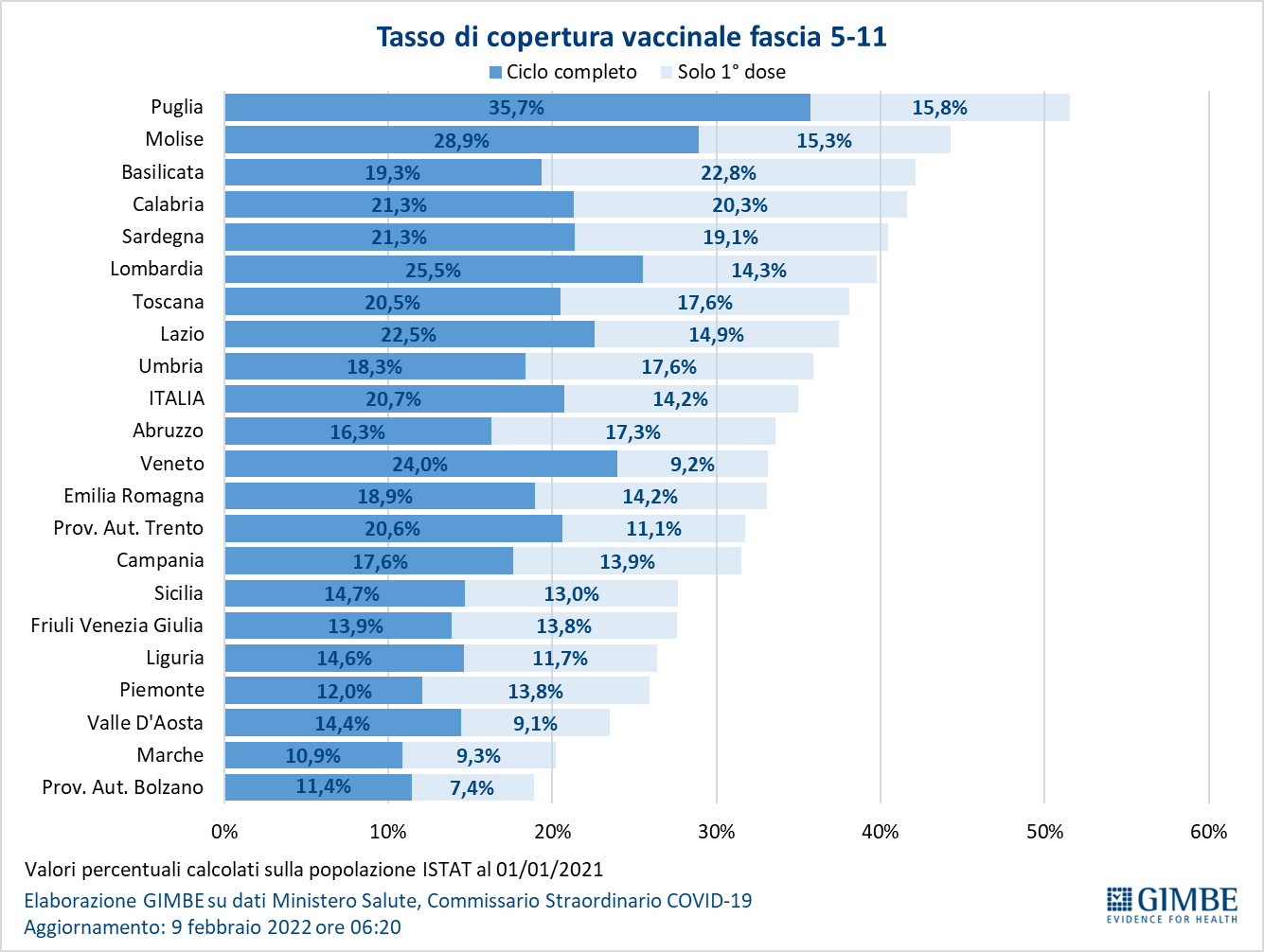
Vaccines: third dose.
As of February 9 (update 06.20), 35,486,095 third doses have been administered, with a 7-day moving average of 225,770 administrations per day (Figure 19). According to the official audience (n. 42,518,205), updated as of February 1, the national coverage rate for third doses is 83.5% with clear regional differences: from 77.5% in Sicily to 89. % of the Aosta Valley (figure 20).
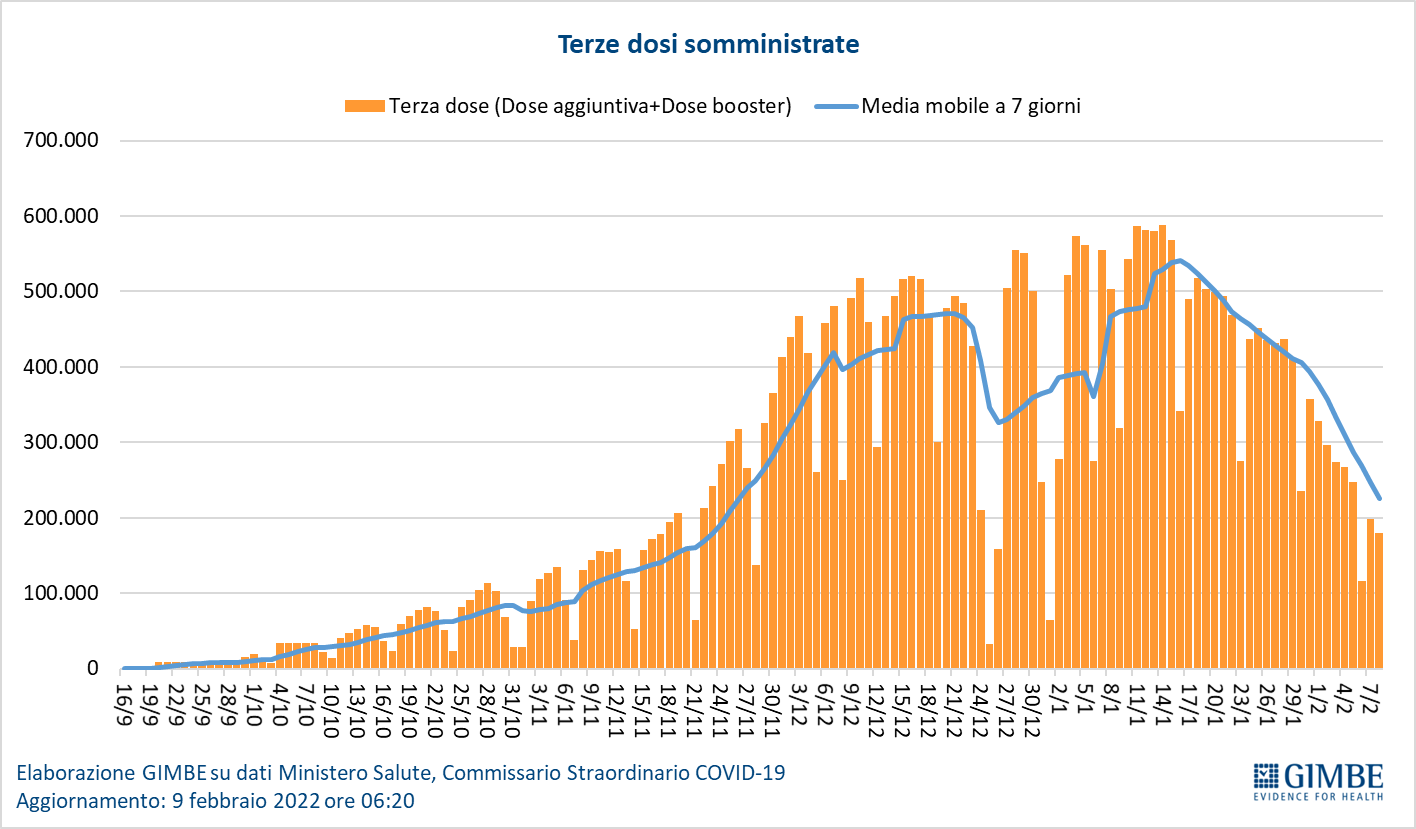
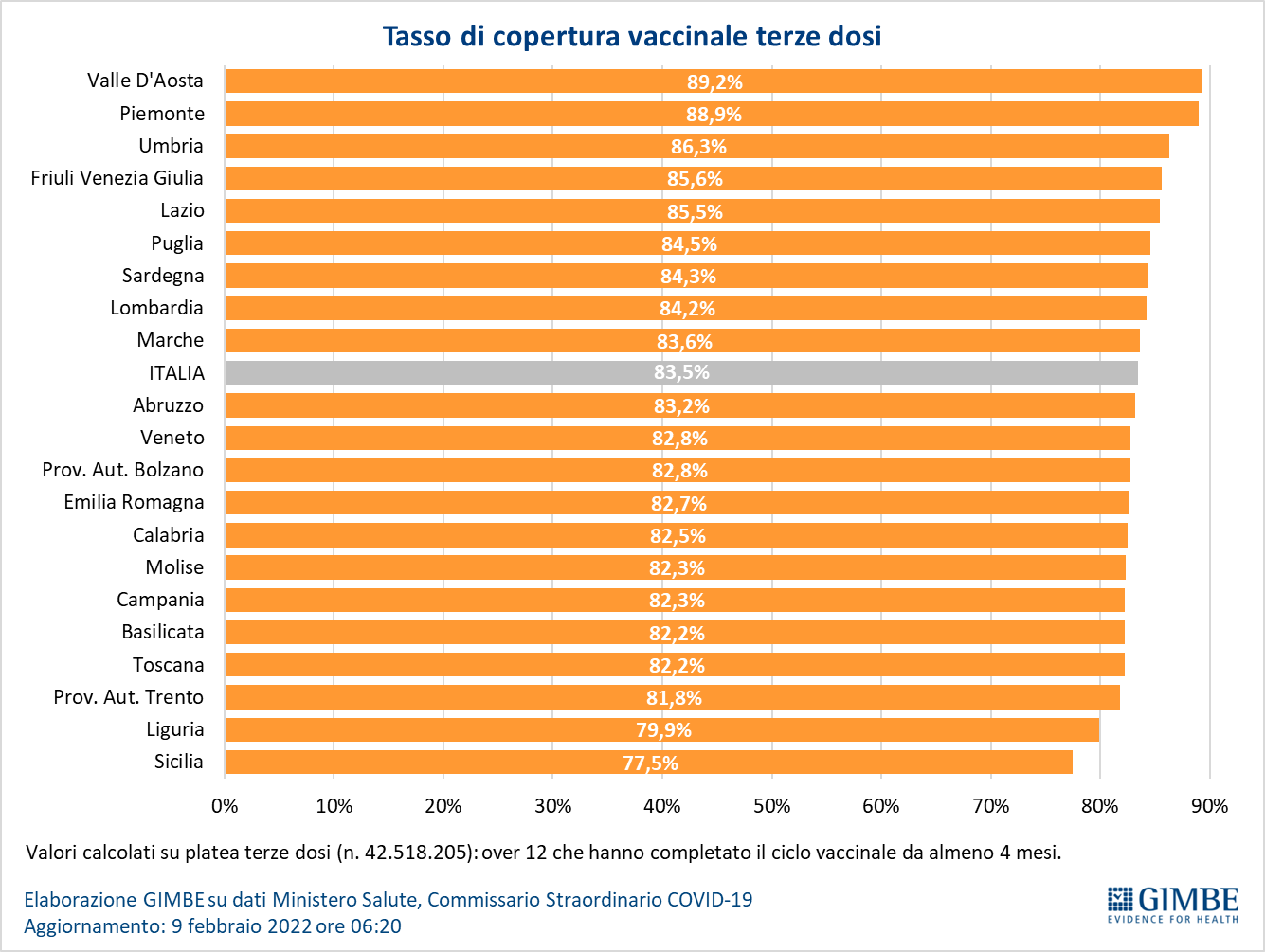
Vaccines: fourth dose.
The European Medicines Agency (EMA) suggested considering it only for the immunocompromised. "Considering that many subjects belonging to this category – underlines Cartabellotta – received the third dose over 4 months ago, we hope for a timely decision on the matter by the Italian Medicines Agency (AIFA) and the Ministry of Health".
Vaccines: effectiveness.
Data from the Istituto Superiore di Sanità demonstrate the reduction in vaccination efficacy starting from 3 months after the completion of the primary cycle and its recovery after the booster is administered. In particular:
- the effectiveness on diagnosis gradually decreases from 63.3% for those vaccinated with two doses within 90 days to 39.5% for those vaccinated for more than 120 days, and then rises to 67.3% after the booster;
- the efficacy on severe disease progressively drops from 90.2% for those vaccinated with two doses within 90 days to 84.8% for those vaccinated for more than 120 days, and then rises to 94.9% after the booster.
Overall, in people vaccinated with a full cycle (plus any booster dose), compared to those not vaccinated, the incidence of diagnosis is reduced in the various age groups (by 40.1-73.3%), but above all of disease severe (71.3-89% for ordinary hospitalizations; 88.8-94% for intensive care) and death (83.2-92.4%) (figure 21).
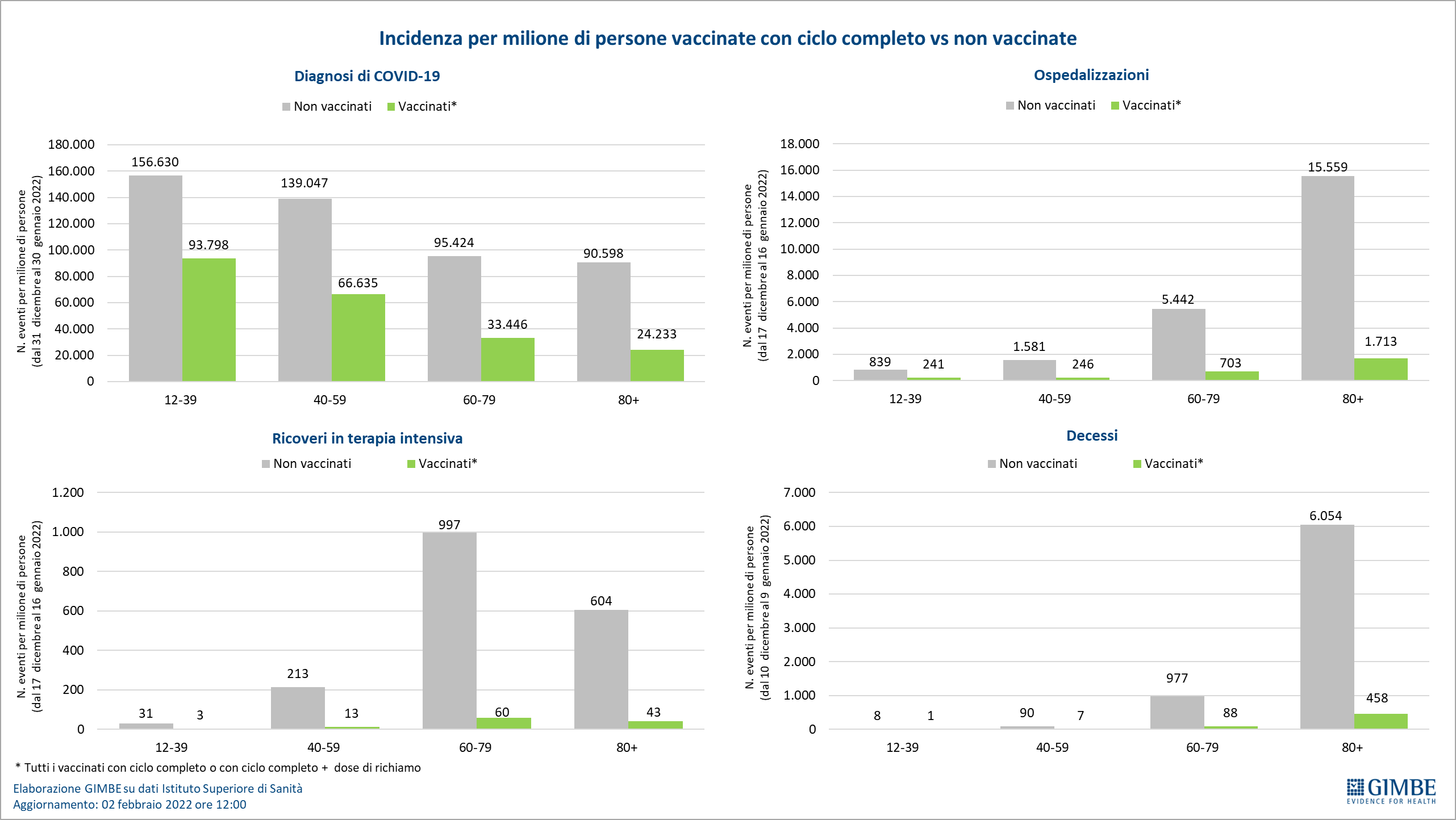
"We are in the descending phase of the fourth wave – concludes Cartabellotta – but the reduction in the circulation of the virus is overestimated by less testing, the drop in pressure on hospitals is slow and often irregular and the death curve still shows no sign of decreasing. However, in the face of high vaccination coverage, booster included, and the arrival of spring, the data legitimize a cautious optimism aimed at the gradual easing of the measures. However, with the expiry of the state of emergency approaching – the extension of which is no longer justifiable in Parliament – terms that have nothing to do with the current situation are insinuating themselves into the scientific and political debate: from the endemic circulation of the virus even to the imminent end of the pandemic. Distortions of reality are very dangerous because excess optimism and disinformation, if on the one hand they do not help to counter the vaccination hesitation, on the other hand they risk legitimizing risky and risky decisions, such as the forfeiture of the obligation to wear a mask in closed environments ".
This is a machine translation from Italian language of a post published on Start Magazine at the URL https://www.startmag.it/sanita/covid-come-calano-contagi-e-ricoveri-report-gimbe/ on Fri, 11 Feb 2022 09:00:04 +0000.
